| A Rhythmic realization for Raimbaut de Vaqueiras’Kalenda Maya |
| 音楽エッセイのページへ戻る | 初期多声音楽 | St.マーシャル楽派へ |
| Leoninのページへ | ノートルダム楽派(conductus)のページへ |
ペロタン(Viderunt Omnes) |
| ペロタン(Alleluja Nativitas) | ペロタン Clausulaのページ | まうかめ堂さんのページへ |
| substitute clausulaのページへ | 中世音楽のページへ | |
| A Rhythmic realization for Raimbaut de Vaqueiras’Kalenda Maya Liduino Pitombeira (Louisiana State University) 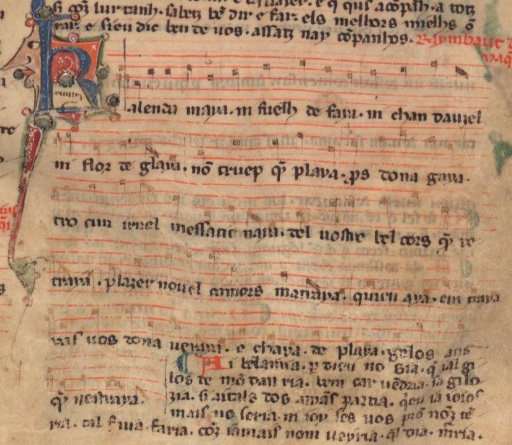 Fig.1 .Afacsimile fromManuscript Rshowing “Kalenda Maya.” (Manuscript Paris, Bibliotheque nationale, f. fro 22543 62r) Kalenda maia Ni fueills de faia Ni chans d'auzell ni flors de glaia Non es qe.m plaia, Pros dona gaia, Tro q'un isnell messagier aia Del vostre bell cors, qi.m retraia Plazer novell q'amors m'atraia E jaia, E.m traia Vas vos, donna veraia, E chaia De plaia .l gelos, anz qe.m n'estraia. Ma bell' amia, Per Dieu non sia Qe ja.l gelos de mon dan ria, Qe car vendria Sa gelozia, Si aitals dos amantz partia; Q'ieu ja joios mais non seria, Ni jois ses vos pro no.m tenria; Tal via Faria Q'oms ja mais no.m veiria; Cell dia Morria, Donna pros, q'ie.us perdria. Con er perduda Ni m'er renduda Donna, s'enanz non l'ai aguda Qe drutz ni druda Non es per cuda; Mas qant amantz en drut si muda, L'onors es granz qe.l n'es creguda, E.l bels semblanz fai far tal bruda; Qe nuda Tenguda No.us ai, ni d'als vencuda; Volguda, Cresuda Vos ai, ses autr'ajuda. Tart m'esjauzira, Pos ja.m partira, Bells Cavalhiers, de vos ab ira, Q'ailhors no.s vira Mos cors, ni.m tira Mos deziriers, q'als non dezira; Q'a lauzengiers sai q'abellira, Donna, q'estiers non lur garira: Tals vira, Sentira Mos danz, qi.lls vos grazira, Qe.us mira, Cossira Cuidanz, don cors sospira. Tant gent comensa, Part totas gensa, Na Beatritz, e pren creissensa Vostra valensa; Per ma credensa, De pretz garnitz vostra tenensa E de bels ditz, senes failhensa; De faitz grazitz tenetz semensa; Siensa, Sufrensa Avetz e coneissensa; Valensa Ses tensa Vistetz ab benvolensa. Donna grazida, Qecs lauz' e crida Vostra valor q'es abellida, E qi.us oblida, Pauc li val vida, Per q'ie.us azor, donn' eissernida; Qar per gencor vos ai chauzida E per meilhor, de prez complida, Blandida, Servida Genses q'Erecs Enida. Bastida, Finida, N'Engles, ai l'estampida. <Abstract> The musical production of the troubadours is transmitted to us through about forty manuscripts of which only four contain musical notation. Rhythmic information is not sufficiently provided because those manuscripts are all written in non-mensural notation. This paper proposes an alternative for the rhythmic interpretation of Raimbaut deVaqueiras’estampida KalendaMaya in light of the theories of rhythm for the music of the troubadours. In order to understand some of the criteria used to edit this kind of music, a brief survey of the rhythmic theories for the troubadours’ repertoire, including some renditions of Kalenda Maya derived from those theories, is provided. Keywords: Kalenda Maya, troubadours, medieval rhythm, modal, isosyllabic, declamatory. トロバドールの音楽の産生は、40ほどの写本を通じて私たちに伝わっているが、4つの写本のみが音楽記譜がなされている。リズムの情報は不十分である。なぜなら、これらの写本は非計量的記譜法で書かれているからである。この論文は、Raimbaut deVaqueirasのestampida KalendaMayaのリズム解釈に対して、トロバドールの音楽のリズム理論に光を当てて、するいくつかの選択を提案する。この手の音楽を校訂するために使われる判断基準のいくつかを理解するために、こうした理論に由来するKalenda Maya のいくつかの校訂を含め、トロバドールのレパートリーに対するリズム理論の簡潔な研究がなされる。 <総論> The musical production of the troubadours is transmitted to us through about forty manuscripts of which only four contain musical notation. Those manuscripts, as pointed out by VAN DER WERF (1984, p.10-11), are all written in non-mensural notation and therefore do not provide enough information regarding rhythm. The purpose of this paper is to discuss and suggest an alternative for the rhythmic interpretation of Raimbaut de Vaqueiras’estampida “KalendaMaya” in light of the theories of rhythm for the music of the troubadours. トロバドールの音楽の産生は約40の写本を通して伝えられているが、そのうち4つだけが音楽記譜がされている。 VAN DER WERF(1984、p.10-11)が指摘したこれらの写本は、すべて非計量的記譜法で書かれているため、リズムに関する十分な情報を提供していない。 本稿の目的は、音楽のリズム理論に照らして、Raimbaut de Vaqueirasのestampida "KalendaMaya"のリズム解釈の代替案を検討し、提案することである。 The composer of “KalendaMaya”was born in Vaqueiras (Provence) probably around 1150. He was a troubadour and companion-at-arms of Boniface I. According to Robert FALCK (2005), only seven of the 35 poems ascribed to him survived with music. The estampida “Kalenda Maya” is his best-known work.Raimbaut probably died in 1207,although some scholars believe that he died only in 1243. "Kalenda Maya"の作曲家Raimbautはおそらく1150年頃、Vaqueiras(Provence)で生まれた。彼はトロバドールで、Boniface I の戦友であった。Robert FALCK (2005)によると、彼に帰された35の詩のうち7つしか音楽が残っていなかった。estampida “Kalenda Maya”は、Raimbautのもっともよく知られた作品である。Raimbautはおそらく1207年に亡くなったが、学者のうちでは、彼が1243年に亡くなったと考える者もいる。 The text of “Kalenda Maya” is found in several manuscripts, but only one preserves the melody.1 According to MCPEEK(1973,p.142), there are six extant estampidas in the troubadour’s repertoire,but “Kalenda Maya” is the only one withmusic and text preserved. “Kalenda Maya”の歌詞は、いくつかの写本に見られるが、ひとつだけがメロディを残している。MCPEEK(1973,p.142)によれば、トロバロールのレパートリーのうち6つの現存するestampidasがあるが、“Kalenda Maya” は唯一の音楽がつき、歌詞が保存されていたものである。 The fact that the estampida is, according to AUBREY (1996, p.x), a genre associated with dance might lead one to imagine that a regular rhythmic edition.usingmodernnotation.would bethe only possible solutionto decode the piece andmake it available for performance. AUBREY(1996、p.x)によると、estampidaが踊りと関連したジャンルであるという事実は、現代譜を用いる規則的なリズム校訂が、作品を解読し演奏を可能にする唯一の解決法であろうという考えを人々に強いるかもしれない。 In fact, almost all the recordings of this piece I have listened to since my first contact with early music (in 1984) present a regular rhythmic rendition or at least a hybrid rendition, in which a free interpretation is concomitantly applied (this is the case of the rendition recorded in 1997 by theSyntagma ensemble.a group in Northeast Brazil. of which I was a member at the time). 実際、1984年の初期音楽との私の接触以降聴いたこの作品のほとんどの録音は、規則的なリズムの演出であり、あるいは少なくとも混合した演出であった。自由なリズム解釈は付随的に適用されていた。 However, in 1984, Hendrik van der Werf, who does not see any evidence that the estampida was a dancing song (VAN DER WERF, 1988, p.55), edited this piece using stemless notes, i.e.,with no clear indication of rhythm(VANDERWERF,1984,p.292-293). In order to understand some of the criteria used to edit this kind of music, Iwill provide in the following paragraphs a brief survey of the rhythmic theories for the troubadours’ repertoire including some renditions of “Kalenda Maya” derived from those theories. しかし、1984年、 estampidaが踊りの歌であるという証拠は見当たらないとしたHendrik van der Werf(VAN DER WERF、1988、p.55)は、この作品を縦線のない記譜、すなわちリズムの徴候のないもので編集した(VANDERWERF 、1984、p.292-293)。 この種の音楽を編集するために使用された基準のいくつかを理解するために、以下のパラグラフで、これらの理論から導かれた「カレンダ・マヤ」の演奏を含む、楽譜のレパートリーのためのリズム理論の簡単な調査を提供する。 There are several theories that study the musical rhythm of the troubadours (and of their French northern counterpart, the trouveres) but they all can be structured in three main groups: modal, isosyllabic, and declamatory. Text is of central importance for all those theories in view of the fact that its relationship with music, in terms of prosody for example, is sometimes the only possible key to decipher the rhythmic structure of the piece as a whole. A description of the most important branches of each theory is given below. トロバドールとフランス北部のトロヴェールの音楽のリズムを研究するいくつかの理論があるが、それらはすべてmodal, isosyllabic, declamatoryの3つの主要なグループで構成されている。歌詞は韻律(prosody)の点での音楽との関係が作品全体のリズム構造を解読するための唯一可能な鍵である、という見方において、あらゆる理論にとって、中心となる重要性を持っている。各理論の最も重要な分岐の説明を以下に示す。 <モーダル理論> Chronologically the modal theory was the first one to be proposed. Both Pierre Aubry, in 1907, and Jean-Baptiste Beck, in 1908, claim to be the authors of this theory.They assert that the music of the trouveres used rhythmic modes based on observations of certain manuscripts, especially one containing Adamde la Halle’sworks, inwhich monophonic settings are written in non-mensural notation and polyphonic settings are written in mensural notation.2 時系列的に、モーダル理論は最初に提案されたものであった。 1907年のPierre Aubryと1908年のJean-Baptiste Beckは、この理論の提唱者であると主張している。彼らは、トロヴェールの音楽はある種の写本、ことにAdamde la Halleの作品を含むものの観察に基づいたリズムモードを使用していた、と主張している。そこでは、モノフォニックの作品は非計量的に記譜され、ポリフォニック作品は計量的に書かれている。 They deduce that if this repertoire can be expressed in both monophonic and polyphonic formats (in which a regular rhythmic interpretation would be mandatory for synchronization since it involves more than one part) then the melodies, when isolated from the polyphonic context, would keep the regular rhythmic shape even if notated with non-mensural signs. Those observations on the northern repertoire are also applied to the southern (troubadours’) repertoire. One important edition of “Kalenda Maya” based on this theory was prepared by GENNRICHER (1960, p.16), which is shown in Example 1. もしもこのレパートリーをモノフォニックとポリフォニックの両方の形式で表現できれば(それには1つの声部以上が含まれているため、規則的なリズムの解釈が同調のために必須である)、メロディーは、ポリフォニックの部分から分離されたときに、非計量的に記譜されていても、規則的なリズムの形を保つだろう。 北部(トロヴェール)のレパートリーでのこれらの観察は、南部(トロバドール)のレパートリーにも適用される。この理論はGENNRICHER (1960, p.16)によるが、それに基づく“Kalenda Maya”の現代譜校訂が、Example 1に示されている。 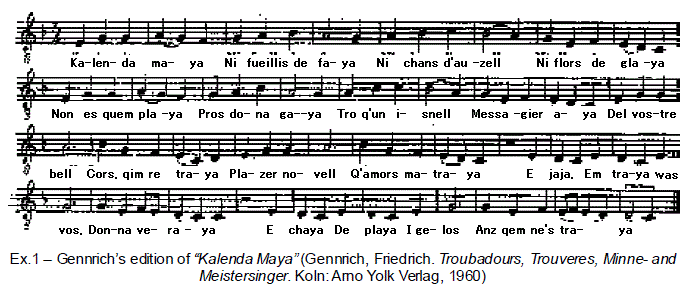 TISCHLER(1989, p.227),whostrongly advocates a metric-rhythmic interpretation of this repertoire, even though it does not follow inflexibly the rhythmic modes, considers that themeter ofmedieval poetry was based on stress rather than on the length of syllables.Another point to be considered is that in this edition the same rhythmic shape is applied for all strophes.2 2John Stevens defines rhythmic mode as “a recurrent metrical pattern of long and short notes.” He says, “the standard system of six rhythmic modes was devised by the theorists of the thirteenth century for the notation and analysis of polyphony. The application of modal rhythm to monophony is a twentieth-century invention.”(STEVENS, 1986, p.508) TISCHLER(1989、p.227)は、このレパートリーの韻律的リズム的解釈を強く主張する。それはリズムモードを柔軟性のない形で追いかけるのではなく、中世の詩歌が、シラブルの長さではなく、アクセント(stress)に基づいていると考えている。この校訂では、すべての音節strophesに対して同じリズムの形が適用されている。 2 John Stevensは、リズム・モードを「長短音の反復的な音律パターン」と定義している。6つのリズムモードの標準システムは、ポリフォニーの記譜と分析のために13世紀の理論家によって考案された、と言っている。モノフォニーへのモーダルリズムの適用は、20世紀の発明である。 I will now present my own metrical-rhythmic rendition of “Kalenda Maya” based on certain rules proposed by the modal theorists and then compare it with Gennrich’s rendition. BECK (1979,p.27) presents five general transcriptional rules for this repertoire, as follows: 1) tonic accents in words are associated with accent in music, 2) duration is increased if an accented syllable coincides with an unaccented beat and vice versa, 3) rhyme is always going to be placed on an accented beat, 4) rhythm defined for the first measure is regularly applied to an entire phrase or even for the whole song, and 5) only one syllable relates to each element in a mode. 私は今、モード理論家によって提案された特定のルールに基づいて、自身の音律リズム的な“Kalenda Maya”の演出を提示し、それをGennrichの演出と比較したい。 BECK(1979、p.27)は、このレパートリーのための5つの一般的な校訂規則を以下のように提示する: 1)言葉の強いアクセントは音楽のアクセントに一致する 2)アクセントのある音節とアクセントのない拍が一致した場合、継続時間が長くなる 3)韻は常にアクセントのついたビートに置かれる 4)最初の尺度のために定義されたリズムはフレーズ全体または歌全体に規則的に適用される 5)モードの各要素には1つのシラブルのみが関連する。 Regarding “Kalenda Maya,” all those above rules can be applied to generate a metric rendition with the exception of rule no.2, because the musical notation does not give any information about accented and unaccented beats. Therefore, I am also going to consider two other observationsmade byAUBREY(2000, p.130) on the songs with measured notation: 1) oxytone rhyme syllables are long, usually preceded by a short note, 2) paroxytone rhymes are always given the rhythm long-long. 「Kalenda Maya」に関しては、規則2を除いて、音律の演出を生成するために、上記のすべての規則を適用することができる。なぜなら、音楽記譜は、拍にアクセントがあるのかないのかに関する情報を提供しないからである。したがって、私は、AUBREY(2000、p.130)によって作られた以下の2つのことobservationsについて考えてみたい。 1)オキシトーン(最後の音節に鋭いアクセントの ある語), 韻のシラブルはlongだが通常はshort音符が先行する 2)パロキシトーン(最後から二番目の音節に、強勢か鋭アクセントが ある語)韻には常にlong-longリズムが与えられている If the text has the rhythm and if this rhythm depends on the syllabic stress, then the first step in the edition consists of determining the stressed syllable for each word of the first strophe (and the results would apply for the remaining strophes). This task would be easy if we knew how the stress was accomplished in Old Occitan. According to Dr. Akehurst3 , the stressed syllable of a word can be expressed in terms of length, loudness, or intonation curve but there is no evidence about the way itwas used in Old Occitan (AKEHURST,2001). 歌詞にリズムがあり、このリズムがシラブルのアクセント(stress)に依存する場合は、校訂における最初のステップは、最初のストロークの各単語のアクセントのあるシラブルを決定することである(そして結果は残りの音節に適用される)。 古オック語でアクセントがどのように扱われたかを知っていれば、この作業は簡単である。 Dr. Akehurstによれば、強調された単語のシラブルは、長さ、音量、または抑揚の観点から表現できるが、古オック語での使用方法に関する証拠はない(AKEHURST、2001)。 My choice is to use length to establish stress because this is the only way to cause direct implication on rhythm.4 Two other specialists in this field corroborate my own stress choice.5 4 Loudness would affect dynamics and intonation would affect pitch. 私の考え(選択)は、アクセントを確立するために長さを使用することである。これがリズムに直接関係する唯一の方法であるためである。.この分野の他の2人の専門家が、私自身のアクセントの選択を裏付けている。 4 音量は強弱に関係し、抑揚は音高に関係する I present below the first strophe of the poem with syllabic division and stress defined by Dr.Stephane Goyette. When necessary, the stress is indicated with an acute accent (´) over the syllable. Numbers within brackets indicate the quantity of syllables for each line. 以下に、Dr.Stephane Goyetteによって定義されたシラブルの分割とアクセントstressの詩の最初の音節の示す。必要に応じて、音節上の鋭いアクセント( ')で強調表示される。括弧内の数字は、各行のシラブル数を示す。 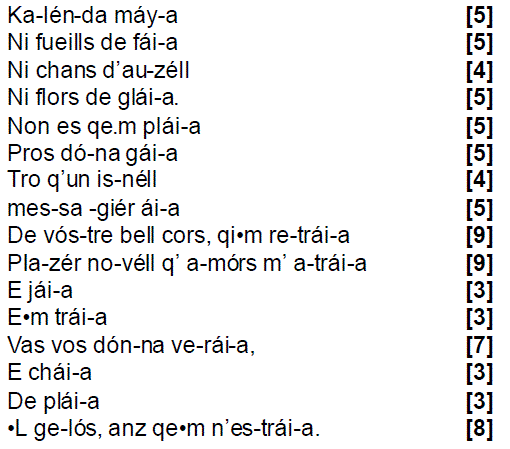 The second step in the editing process consists of notating the natural rhythm of the poem based on some of the rules mentioned above. Example 2 shows the result obtained for the first four lines with the application of two basic rules: 1) tonic accents in words are associated with accent in music and 2) paroxytone rhymes are always given the rhythm long-long (even the oxytone rhymes in the poem, such as “zell” in the third line, have their value expanded by the two-note ligature and become pseudo-paroxytone−see Fig.1; this fact equalizes the number of syllables, i.e., the third line that has four syllables is artificially adjusted to five syllables). 校訂プロセスの第2段階は、上記の規則のいくつかに基づいて詩の自然なリズムを記譜することである。 Example 2は、最初の4つの行について、以下の2つの基本的な規則を適用して得られた結果を示す: 1)単語の強調アクセントは音楽のアクセントに一致する 2)パロキシトーン韻は常にlong-longリズムを与えられる( 3行目の "zell"のような、詩のオキシトーン韻でさえ、2音連結符によってその音価が拡大されたり、あるいは偽のパロキシトーンとなる−Fig.1参照。この事実は、シラブルの数、すなわち4つのシラブルを持つ第3行が5つのシラブルに適応するようになっている)  My edition disagreeswith two aesthetic principles of the modalists expressed in Beck’s book, but not in the rules (BECK, 1979, p.28-29). First, they considered that this entire repertoire was expressed in ternary subdivision because until the beginning of the 14th century that was the only way the musicians knew how to express music. If we do this modification by shortening the figure of the second beat it results in mode 1 (long-short) embellished with fractio mode in some places. 私の校訂は、Beckの本で表現されたモーダル主義者の2つの審美的な原則に反するが、しかしそれは規則違反ではない(BECK、1979、p.28-29)。第1に、Beckらは、この全レパートリーは、14世紀の初めまで、音楽家たちが音楽を表現する方法を知っていた唯一の方法であったため、3拍子で表現されたと考えた。 2番目の拍を短くしてこの変更を行うと、いくつかの場所でfractio modeで装飾された第1モード(long-short)という結果になる。 Second, an anacrusis can always be more elegantly accommodated in the following measure. Even with these two alterations, my edition would still be different from Gennrich’s because he gives ornamental figures (for example, a descendent plica.-fourth figure in themanuscript shown in Fig.1, and a ligature.fourteenth figure) the same status of regular notes and this provokes desynchronization between accented syllables and accented beats.Therefore, the natural stressed syllable will never coincide with the accented beat, thus contradicting the very first rule of the modal theory (see 5th paragraph above). A third step in the editing process would consist of matching the suggested rhythm with the pitches in themanuscript. However, this step is beyond the scope of this paper, which is to analyze only the rhythmic aspect of the piece. 第2に、弱起は常に、あとの方で、よりエレガントに適応させることができる。この2つの交代であっても、私の校訂はGennrichのそれとは異なっている。なぜなら彼は、装飾的な形態(例えば、 Fig.1で示された写本の第4番目の音符の下降plicaと第14番目の音符の連結符)を記しているからである。規則的な音符とこの装飾的な形態との同じ状況は、アクセントのあるシラブルとアクセントのある拍の非同調を提言している。したがって、自然に強調されたシラブルは、アクセントのある拍とは決して一致しないので、モーダル理論の最初の規則と矛盾するのである(第5段落参照)。校訂プロセスの第3のステップは、示唆されたリズムと写本のピッチとを一致させることからなる。しかし、この手順は本書の範囲を超えている。これは作品のリズムな面のみを分析することである。 The exercise of trying to edit the rhythm of “KalendaMaya” using the modal theory proves to be a confusing task because of the lack of objectivity of the rules, but this is, at the same time, good since it is more open to different interpretations. To conclude my observations on this theory, Example 3 shows another rhythmic rendition of “KalendaMaya” byMCGEE(1989, p.49-50), who considers that the rhythm should be derived from the melody itself. This is yet more subjective than deriving the rhythm from the text. Let us now examine the second rhythmic theory. モード理論を用いて“KalendaMaya” のリズムを校訂しようとする試みは、規則の客観性の欠如のために混乱する仕事であるが、これは同時に、異なる解釈に対してよりオープンなので、良い事でもある。 この理論についての私の観察を終えるにあたり、Example 3はMCGEE(1989、p.49-50)による「KalendaMaya」の別のリズム演奏を示している。彼は、リズムがメロディ自体から由来すると考えている。 これはテキストからリズムを引き出すよりも主観的である。 次に、第2のリズム理論を見てみよう。 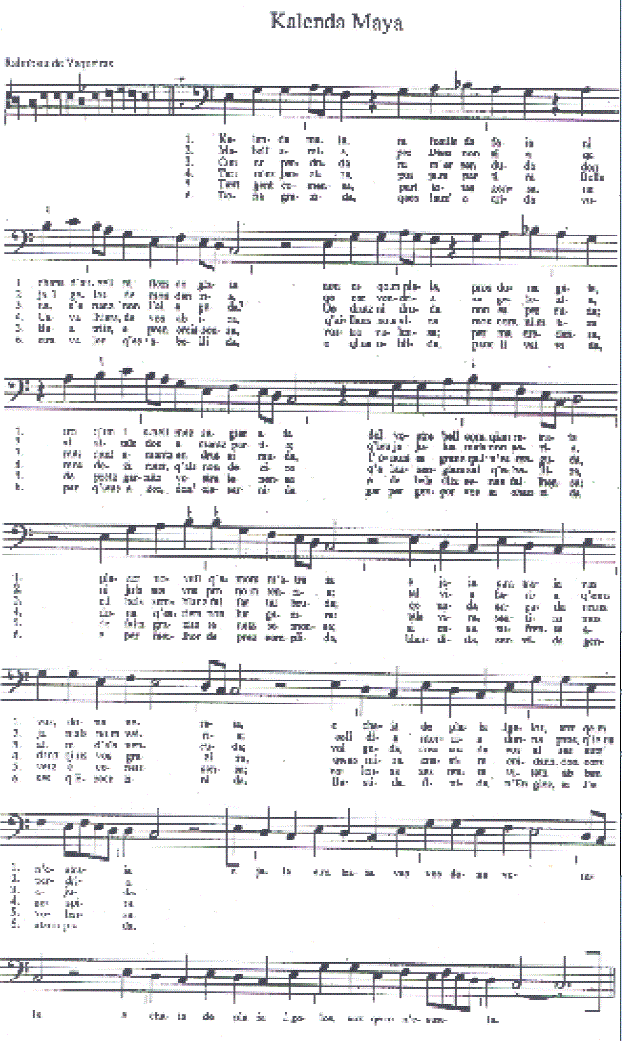 Ex.3 . McGee’s edition of “Kalenda Maya” (McGee, Timothy J. Medieval Instrumental Dances. Bloomington: Indiana University Press,1989) <isosyllabic 理論> The second theory.isosyllabic.was mainly proposed by the Italians Sesini, Paganuzzi, and Monterosso in 1942,1955,and 1956, respectively,and later adopted and refined by John Stevens. According to STEVENS (1986, p.414, n.2), Ugo Sesini noticed that syllables in Romance languages had approximately the same duration and that in the notation of troubadour’s songs each syllable was associated with one neume (like in late medieval plainchant). Then, he proposed that all syllables should be interpreted with equal duration. Stevens also mentions (in the same passage) that for Sesini.and for Monterosso.the poetry had all the rhythmic information necessary to interpret the piece,and thatPaganuzzi proposed a kind of performance with free rhythmic values similar to the Solesmes interpretation of Gregorian chant. 第2の理論は、それぞれ1942年、1955年、1956年にイタリアのSesini、Paganuzzi、Monterossoらによって主に提案したものであり、後にJohn Stevensによって採用され、洗練された。 STEVENS(1986、p.414、n.2)によれば、 Ugo Sesiniは、ロマンス語のシラブルはほぼ同じ長さであり、トロバドールの歌の記譜法においては、それぞれのシラブルがひとつのネウマ(音符)で表される(中世後期のプレインちゃんとのように)ということに注目している。さらに彼は、すべてのシラブルは等しい長さで解釈されるべきである、と提案した。Stevensは、Sesini.と Monterossoのために、詩はすべてその作品解釈のために必要なリズム情報を持っている、とも言及している。さらに、Paganuzziは、グレゴリアンチャントのソーレム式解釈と同じような自由なリズム解釈による演奏を提案している。 Stevens’ model establishes that, since medieval poetry is governed by syllable count and rhyme (and not by syllabic stress as proposed by the modalists) and medieval monophonic melodies are mostly notated having one neume to each syllable, then monophonic music should be interpreted in an isosyllabic manner, i.e., the syllables should have approximately equal temporal distribution. Stevens uses the same notation as declamatory theorists, as one can see later in this paper, i.e.,stemless notation, but I could not find any rendition of “KalendaMaya” based on his method.Also Sesini did not make any edition of “KalendaMaya.” 6 However, McPeek’s rendition, reproduced in Example 4, seems mostly to follow the isosyllabic principles (MCPEEK, 1973, p.147). Stevensのモデルは、中世の詩はシラブル数と韻(そしてモード理論家によって提案されたようなシラブルの強調にはよらない)によって支配され、そして中世のモノフォニックメロディは、ひとつひとつのシラブルに対してひとつのネウマ(音符)を持つように記譜されている。さらに、モノフォニック音楽はisosyllabicなやり方で、すなわち、シラブルはほとんど等価で発音されるべきである。Stevensはdecmamatoryな理論家によるのと同じ記譜、すなわち、縦線のない記譜を使っている。しかし、彼の方法に基づいて“KalendaMaya” の演出を見つけることはできなかった。またSesiniは “KalendaMaya”の校訂はしなかった。しかし、 Example 4で示されたMcPeekの校訂は、大部分が isosyllabicの原理に従っているようである(MCPEEK、1973、p.147 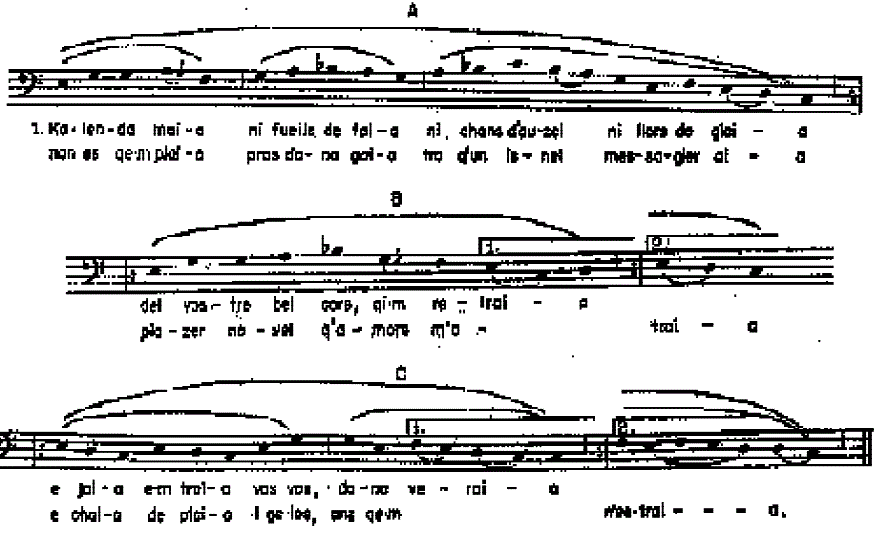 Ex.4 . McPeek’s edition of “Kalenda Maya” (McPeek, Gwynn. “Kalenda Maya: a Study in Form.” In Medieval Studies in Honor of Robert White Linker, ed. Brian Dutton, J. Woodrow Hassel, Jr. and John Keller, 141-154. Valencia (Spain): Editorial Castalia, 1973. <declamatory理論> The declamatory theory was proposed by Hendrik van der Werf in 1967 and adopted by Christopher Page in 1986. Van der Werf believes that free rhythm was used to perform the chansons of the troubadours and trouveres and he employs the term declamatory rhythm to signify that the performer basically used to “declaim the poem without the music” in order to identify its rhythmic shape (VAN DER WERF, 1972, p.44). The sound produced in the recitation was then coordinated with the syntax and structure of the text in order to reveal the natural rhythm of the poem, which for van der Werf is neither in the melody nor in the text in isolation. declamatory 理論は、1967年にHendrik van der Werfによって提案され、1986年にChristopher Pageによって取り上げられた。Van der Werfは自由なリズムがトロバドールたちのシャンソンの演奏に使われたと信じ、declamatoryリズムという用語を、演奏者が基本的にはリズムの形を特定するために "音楽のない詩を諳誦"を行っていた(VAN DER WERF、1972、p.44)ことを明らかにしている。 その後、暗唱の中で生み出された音は、詩の自然なリズムを表すために、テキストの構文と構造と調和されるようになった。Van der Werfにとってはメロディもテキストも分離させなかった。 Moreover, the manuscript of the works of Adam de la Halle―the same one used as reference by the modalists to justify their hypothesis (see 4th paragraph)―.is also used by van der Werf to show that the scribe used both mensural (for polyphonic genres) and non-mensural (for the majority of the monophonic songs) notations merely because many melodies were really unmeasurable and not because a mensural way of performance should be deduced for the entire repertory. However van der Werf says that precisely measured songs can be found in the manuscripts. Example 5 shows an excerpt from van der Werf’s edition of “Kalenda Maya” based on his declamatory theory.7 As one can perceive, the music score does not provide any rhythmic information. さらに、 Adam de la Halleの作品の写本については、 van der Werfによって、書記が、計量記譜法(ポリフォニー分野)と非計量記譜法(主としてモノフォーにー作品)の両方の記譜法を用いていたことが明らかにされている。それは、多くのメロディが実際には計量的ではないために、計量的なの記譜にもとづく演奏法が全体のレパートリーのために当てにされるべきではないからである。しかしながらvan der Werfは、計量的な作品が確かに写本中に見いだされると述べている。 Example 5は、van der Werfの「Kalenda Maya」の declamatory 理論に基づいた抜粋を示している。.7 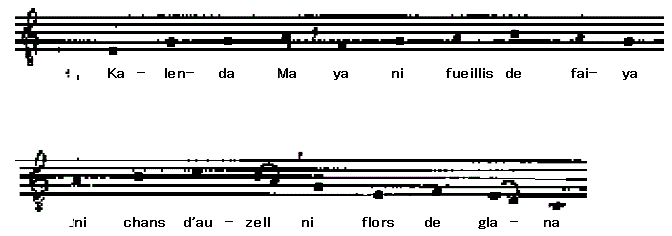 Ex.5 . Van der Werf’s edition of Kalenda Maya (Van Der Werf, Hendrik. The Extant Troubadour Melodies:Transcriptions and Essays for Performers and Scholars.With Texts Edited by Gerald A. Bond. Rochester, NY:by the author, 1984 I am not going to make renditions of KalendaMaya based on isosyllabic or declamatory theories because they would look practically the same as the ones shown here, since they basically consist of reproducing literally the manuscript without introducing any rhythmic bias. In those two theories, the true work of rhythmic interpretation is left to the performer. Hendrik van der WerfやChristopher Pageは、基本的にリズムへの偏見を生ずることなく、文字通り写本の再現について基本から構成しているので、ここで示されているものと実質的に同じに見えるので、私は isosyllabicまたはdeclamatory理論に基づいてKalendaMayaの校訂を行うつもりはない。 この2つの理論においては、リズムの解釈は演奏者に委ねられているのである。 <まとめ> I have examined several possibilities for understanding the rhythm of Kalenda Maya. Although all the theories regardingthe rhythmicinterpretation of this repertory present reasonablesolutions, no one seems to have the complete truth since there are stillmany unanswered questions with respect to text, music, and the relationship between both. As a performer, I would choose a hybrid rendition by applying equally mensural (quasi-modal) and declamatory interpretations, in order to express both lyrical and rhythmical (dance-like) aspects of the piece. 私はKalenda Mayaのリズムを理解するためのいくつかの可能性を検討した。 このレパートリーのリズム解釈に関するすべての理論は、合理的な解決策を提示しているにもかかわらず、テキスト、音楽、および両者の関係に関してまだ未解決の質問がたくさんあるので、誰も完全な解決策があるわけではない。 演奏家として、作品の叙情的でリズミカルな(踊りのような)様相を表現するために、ここでは、モード様解釈とdeclamatory解釈を適用して、両者を混ぜ合わせた校訂を選択したい。 For the declamatory portion I would use Van der Werf’s rendition (Ex.5). For the mensural interpretation I would use ternary subdivision.for the same reason pointed out above by Beck (see 8th paragraph).and synchronize the accented beats with accented syllables (an anacrusis would be necessary at the beginning). Example 6 shows this suggested mensural rendition for the first sixteen lines.8 Perhaps the present rendition is not the way that Kalenda Maya was performed during Vaqueiras’ time,but it is presentedhere as one possible andinformed solution. declamatory部分については、Van der Werfの校訂を使用する(例5)。 計量的解釈については、Beck(上記第8段落参照)によって指摘されたのと同じ理由で、つまり、アクセント付きのシラブルをアクセント付きの拍と同期させるのと同じ理由で3拍子を使用する(弱起は最初に必要となる)。 例6は、最初の16行に対して計量的校訂を提案している。おそらく現在の演出は、Vaqueirasの時代にKalenda Mayaが実行された方法ではないが、可能な限り情報を得た解決として提示されている。 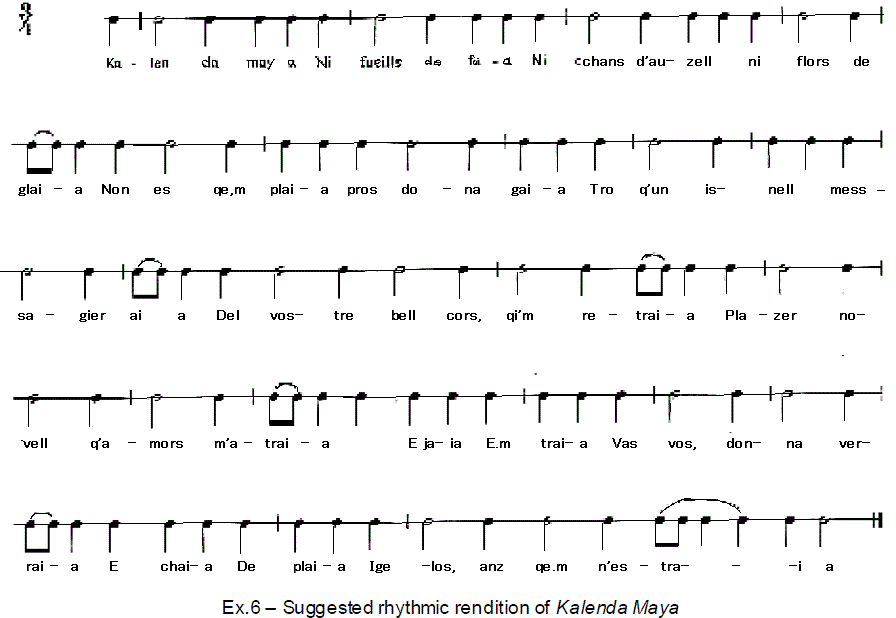 |